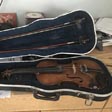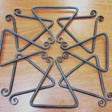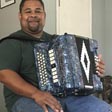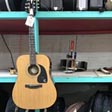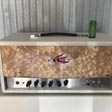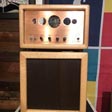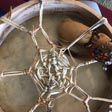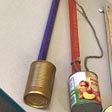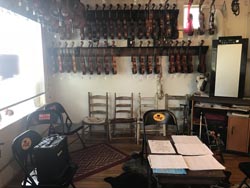Innovation, Tradition, and Change in Louisiana Musical Instrument Making and Repair
By Holly Hobbs

Introduction
Musical instrument making and repair is a longstanding traditional occupation throughout Louisiana. Individuals, personal repair shops and music stores service instruments—from stringed to brass, woodwinds, drums, nontraditional instruments and more—for musicians performing in all musical genres and beyond. Some instrument building/repairing artisans and repair shops are narrowly focused on creating and/or repairing certain types of instruments—such as electric guitars or tube amplifiers—while others service a wider range of instruments and musical needs. Some artisans have learned through the apprenticeship tradition, while others are self-taught or more formally trained. While traditional instrument making and repair is indeed threatened, most artists remain hopeful about the continuation and cultural/musical maintenance of the tradition.
This essay profiles twenty instrumentally and demographically diverse makers and repairers from throughout the state of Louisiana, including a number of musicians who are less well documented in the existing ethnographic research. Certainly, there are many star builders and repairers in Louisiana, but thankfully, many of these have already been well documented. Represented in this essay are a few of the lesser-known voices, which contribute to a more well-rounded and broadly informative understanding of the topics at hand.
African American and Creole instrument makers and repairers are an unexpected minority among musical instrument makers today in Louisiana. The long tradition of African American/Creole piano repairers in New Orleans, for example, is now virtually gone, with Preservation Hall Jazz Band's pianist, Rickie Monie, stating that the last African American piano repairer he knew of left in New Orleans (besides himself) had moved to Texas after Hurricane Katrina. There are nonetheless numerous bright spots in this area, including the thirty-something African American stringed instrument repairer and double bass builder, Charles Lumar. Another is the Creole artist Dexter Ardoin in the Lafayette area, who is one in a long line of Creole instrument makers and builders in that area and a member of the famed Ardoin family, which includes his grandfather, the Creole French musician Bois Sec and father Morris Ardoin. Both Lumar and Ardoin's words are included in this essay.
In contrast to the somewhat surprising decline of African American and Creole builders and repairers in Louisiana today, women are an expected minority. But as with all things in folklife and ethnography, difficulty locating female builders/repairers isn't necessarily a direct reflection of the lack of female involvement in the tradition, as much of the female experience still tends to be centered around and within the private home. Traditional female art is still often created and conducted in private, rather than in public. Nonetheless, the experiences of two female instrument makers and builders (Gladys Miller and Anya Burgess) are included in this essay, along with a bit from Junior Martin's daughter, Pennye, who has learned accordion building and repair from her father.
There is a small but thriving community of First Nation instrument makers and builders in Louisiana, including Raymond Reyes, a traditional Native drum maker from Port Sulphur, Louisiana who offers his story here as well.
It was also important to include voices that could speak to all ranges of instrument making and repairing experience. Two artists—Frank D'Arcangelo and Max Theriot—are not owners of music stores, but rather workers or managers who speak to that unique experience. Ultimately, the group of artists highlighted attempts to be as representative and as broad as possible, offering unique voices and experiences that contribute to a heightened understanding of the state of musical instrument making and repair in Louisiana today.
In terms of guiding frameworks, the role of the music store in Louisiana today and the role of innovation in instrument making and repair became the focus over time. All artists whose stories are detailed in this essay speak to one or both of these themes, offering us a better understanding of the state of contemporary local music shops and the key importance of innovation as a way of maintaining tradition. As with all things, innovation and change are necessary components in keeping tradition alive and thriving. Tradition is not static: it is an ever-changing, dynamic, living process of maintaining the aesthetics of a community over time.
Process and Themes
The majority of artists in this essay stated they felt their tradition was threatened. A small minority of others, like Steve Walden, a First Nation guitar maker, said that we were actually in a golden age precisely because the tradition was threatened, and that he felt more support for his art than at any other time in his career. Walden also noted that the Internet has been extremely helpful in seeking out and finding like-minded individuals with whom to share information, ask questions, and provide support. The majority of artists, however, contradicted this statement, saying that the Internet has been directly responsible for the loss of the tradition and it has been difficult for them (at least for those who had Internet access and technological fluency) to find a sense of community online. Frank D'Arcangelo, a drum repairer and builder at Ray Fransen's Drum Center in New Orleans, stated that: "In the last 10 years or so, musical instruments have become disposable to people. People used to keep their instruments. Instruments are so cheap now, I can't buy parts and build a drum to compete with people buying drums online from China. With the advent of the Internet, it has crushed local artisanship." The impact of the Internet on instrument making/repair—and traditional music stores as a whole—is complex, and while it has indeed offered new forms of community and new sales opportunities (many of the guitar makers, in particular, sell a large portion of their work online), it is undeniable that the web has been a direct assault on the tradition. In what follows, artists flesh out these ideas, offering thoughts on changes they've witnessed over time and what it takes to operate a successful music store today.
In terms of learning processes, many of the artisans were nearly fully self-taught, augmenting self-teaching with books or tips from other makers. It would be a reasonable assumption that the classical tradition of apprenticeship might be the norm, but many musicians actually learned through the experience of working on their own instruments first, taking them apart and putting them back together, experimenting on different ways of creating different sounds with their first instruments, and so forth. It was knowledge gained through necessity: of being, in many cases, a young person and not having the money or ability to find an instrument repairer on their own and therefore experimenting to teach themselves how to do their own repairs.
The small music store continues to be central to many of the careers of independent instrument makers and repairers. If not directly involved with a local music store, many artists still use these stores as community spaces, to learn, share ideas, trade knowledge, etc. Many of those directly involved with music stores—as workers, owners, or builders/repairers working through a shop—stated that not only is it imperative to match the prices available online, but also find that the key to their staying in business is to offer lessons, instrument rentals, and excellent personalized customer service to their clients: in effect, to do the things that are largely unavailable online. Of course, this means that certain things have suffered as a result. Many artists involved with music stores stated that they can no longer carry the amount of inventory they once did, as it is simply too costly to stock 40 different brands of guitars, for example. Instead, most music stores have narrowed their inventory greatly, streamlining what they carry and choosing their inventory strictly based on what sells the most. One sad reality is that piano sales over the last decades have tremendously declined. Shreveport Music, which opened in 1910 as a piano sales store, now no longer carries pianos at all—only digital keyboards.
Two central themes arose in this project. The first theme involves a passion for the work—a calling, in many cases—that developed organically but quickly became a life's work. Many artists stated that they kept on with their art, even when it did not make financial sense or when it created hardships for their lives. Most stated that they began in their youth to take things apart and put them back together and began teaching themselves in this way. Most talked of a passion for putting things together and making them work better than they had before; of beautifying and improving upon existing instruments; of making things with their hands; and of the long process of teaching themselves to create the perfect sound, as they themselves defined it. Some artists had a background in woodworking or construction, as in the case of Junior Martin and Dexter Ardoin; others came to the art frustrated because they could not find what they were looking for in existing instruments, as in the case of Holger Notzel and Jeff Richard. All artists found joy in their work, finding deep satisfaction in creating, adapting, restoring, building, and improving.
The other central theme is that of the importance of repurposing existing materials. Most artists expressed sadness at today's "throw-away culture." Jeff Richard, a stringed instrument repairer in Baton Rouge, said, "I try to make things that last 100 years, not three years." The importance of longevity was a central theme across all artists' stories, along with the importance of maintaining the old ways in the face of what many saw as unsustainable technological development. This is not limited to the instruments themselves: many artists creatively adapt or transform existing tools into original pieces that aid them in their development of unique or uniquely adapted instruments. All artists found pride in small things and small details.
The Makers and Repairers
Represented here are outlines of each artist's journey to instrument building and repair, highlighting their key insights as a way of defining a shared set of values and characteristics that can contribute to a heightened understanding of the state of Louisiana instrument making and repair today.


